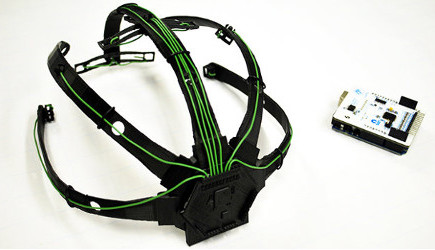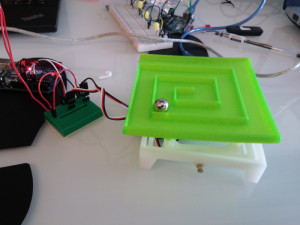Creating Mind-controlled Games With An Arduino-based Brain Computer Interface
March 26, 2015
on
on

OpenBCI is an open source brain computer interface (BCI) aimed at the maker movement. Using the OpenBCI platform for the first time, Daniel Harari and his friends created a 3D printed mind-controlled Labyrinth game in little more than a day at the Brainihack hackathon in Tel Aviv.
OpenBCI is a programmable EEG-platform that lets you read your brainwaves off of a monitor or use your brain signals as input for a computer. I wrote about OpenBCI back in December 2013 when creators Joel Murphy and Conor Russomanno ran a crowdfunding campaign to take their Arduino based prototype to the next level.
They created an open source BCI system because they felt the future of mind-controlled devices should not be in the hands of a few companies but open to anyone who's interested. At the end of January 2014 they'd raised 215% of their initial $100.000 goal.
Scarcely a year later the OpenBCI system – now enhanced with a Bluetooth module for wireless communication – made its appearance amongst its proprietary counterparts Emotiv and NeuroSky at Brainihack. The 36-hour hackathon aimed at developing BCI applications was hosted in the Tel Aviv offices of Autodesk, March 13-14.
Daniel Harari, Gal Weinstock and Maxim Altshul developed a mind-controlled Labyrinth game during Brainihack even though they'd never worked with the OpenBCI system before. The three Israeli-based students received some help from Russomanno to get started but Harari said the platform is 'really easy to work with'.

Labyrinth is a dexterity game that has you tilt a platform on two axes to maneuver a ball to its destination while avoiding holes in the playing field.
The student's labyrinth was printed on the spot with a home-made 3D printer they'd brought with them. They used two Arduino-controlled micro servo motors to control the platform's tilt. The maze is very simple because there is a time delay of several seconds between sending out the brain signal and actuation of the servo motors. That makes it impossible to imitate the quick and subtle movements of the original hand-controlled game and requires a much simpler playing field.
Perhaps the greatest challenge was isolating two different kinds of brain signals to have one person operate the two servo motors. The three built on code of a previous OpenBCI project which used only one type of brain signal and therefore needed two people to control two separate functions. By adding a second brain signal Harari, Weinstock and Altshul made mind-controlled Labyrinth into a single player game.
On his website Harari provides a detailed write-up of how they got the system to work.
Photo of the Labyrinth game: source harariprojects.com
OpenBCI
OpenBCI is a programmable EEG-platform that lets you read your brainwaves off of a monitor or use your brain signals as input for a computer. I wrote about OpenBCI back in December 2013 when creators Joel Murphy and Conor Russomanno ran a crowdfunding campaign to take their Arduino based prototype to the next level.
They created an open source BCI system because they felt the future of mind-controlled devices should not be in the hands of a few companies but open to anyone who's interested. At the end of January 2014 they'd raised 215% of their initial $100.000 goal.
Brainihack
Scarcely a year later the OpenBCI system – now enhanced with a Bluetooth module for wireless communication – made its appearance amongst its proprietary counterparts Emotiv and NeuroSky at Brainihack. The 36-hour hackathon aimed at developing BCI applications was hosted in the Tel Aviv offices of Autodesk, March 13-14.
Labyrinth game
Daniel Harari, Gal Weinstock and Maxim Altshul developed a mind-controlled Labyrinth game during Brainihack even though they'd never worked with the OpenBCI system before. The three Israeli-based students received some help from Russomanno to get started but Harari said the platform is 'really easy to work with'.

Labyrinth is a dexterity game that has you tilt a platform on two axes to maneuver a ball to its destination while avoiding holes in the playing field.
The student's labyrinth was printed on the spot with a home-made 3D printer they'd brought with them. They used two Arduino-controlled micro servo motors to control the platform's tilt. The maze is very simple because there is a time delay of several seconds between sending out the brain signal and actuation of the servo motors. That makes it impossible to imitate the quick and subtle movements of the original hand-controlled game and requires a much simpler playing field.
Harnassing brain signals
Perhaps the greatest challenge was isolating two different kinds of brain signals to have one person operate the two servo motors. The three built on code of a previous OpenBCI project which used only one type of brain signal and therefore needed two people to control two separate functions. By adding a second brain signal Harari, Weinstock and Altshul made mind-controlled Labyrinth into a single player game.
On his website Harari provides a detailed write-up of how they got the system to work.
Photo of the Labyrinth game: source harariprojects.com
Read full article
Hide full article



Discussion (0 comments)